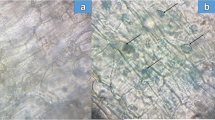Summary
A study was made of the relative influence of nitrate and soil pH on mycorrhiza development in seedlings of loblolly pine (Pinus taeda L.). The investigation was conducted in the greenhouse, using as the growth medium topsoil collected from a young pine plantation.
Lime-induced Fe-deficiency occurred at pH 7.5, resulting in chlorotic seedlings with few mycorrhizas. Chlorosis was corrected, and normal mycorrhiza development restored, by adding Fe-EDTA without altering soil pH.
Application of 18 1/2, 37, and 74 pounds of N per acre as NaNO3 reduced mycorrhiza development at age 21 weeks, but had no effect at age 45 weeks. At 21 weeks, the degree of infection varied inversely as the percentage total N in seedling roots. The effect of NaNO3 was due to the nitrate ion, since Na2CO3 did not reduce mycorrhiza development even though it raised soil pH.
Alkalinityper se did not affect mycorrhiza formation in loblolly pine seedlings, but only indirectly through its influence on host nutrition. Normal mycorrhiza development was possible at pH values of 7.2 and 7.5, provided Fe deficiency was corrected, and soil nitrate level was kept low. The results may be interpreted in terms of the carbohydrate — nitrogen balance in the root tissues.
Similar content being viewed by others
References
Armstrong, E. F. and Armstrong, K. F., The Carbohydrates, Longmans, Green & Co., London (1934).
Björkman, Erik, Über die Bedingungen der Mykorrhizabildung bei Kiefer und Fichte. Symb. Bot. Upsaliens.6(2), 1–190 (1942).
Bonner, James, Plant Biochemistry. Academic Press Inc. New York (1950).
Dale, J., McComb, A. L., and Loomis, W. E., Chlorosis, mycorrhizae and the growth of pines on a high-lime soil Forest Sci.1 148–157 (1955).
Handley, W. R. C. and Sanders, C. J., The concentration of easily soluble reducing substances in roots and the formation of ectotropic mycorrhizal associations — a reexamination of Björkman's hypothesis. Plant and Soil16 42–61 (1962).
Harley, J. L., Mycorrhiza. Proceedings, Symposium on factors determining the behaviour of plant pathogens in soil, Berkeley, California, April 1963 (in press).
Harley, J. L. and Waid, J. S., The effect of light upon the roots of beech and its surface population. Plant and Soil7 96–112 (1955).
Richards, B. N., Fertilizer requirements ofPinus taeda L. in the coastal lowlands of subtropical Queensland. Qld. Dept. Forestry Bull.16 (1961).
Richards, B. N. and Wilson, G. L., Nutrient supply and mycorrhiza development inCaribbean pine. For. Sci.9 405–412 (1963)
Author information
Authors and Affiliations
Rights and permissions
About this article
Cite this article
Richards, B.N. Mycorrhiza development of loblolly pine seedlings in relation to soil reaction and the supply of nitrate. Plant Soil 22, 187–199 (1965). https://doi.org/10.1007/BF01373990
Received:
Issue Date:
DOI: https://doi.org/10.1007/BF01373990




